Reading this post via email or mobile version? Want to read comments and enter your own? Want to see posts from other years or even previous posts from this year? Just click on the post title to access our full web page.
This was our third and last stop in Chile's capital of Santiago after trips away to Easter Island and Valparaíso. Before leaving the next day for Argentina, we wanted to see a couple of more sights. The first was the block-long Biblioteca Nacional or National Library which was founded in 1813, had one of the oldest and most extensive collections in South America.
I wish my shot of the stained glass were a lot better but I hope at least you get a sense of its beauty.
One of the most important collections of early Latin American print work was in the exquisite second-floor Sala José Toribio Merino named, strangely enough in my opinion, after one of leaders of the 1973 coup. The three levels of books in the room were accessible by curved wood balconies and lit by massive chandeliers.
Prior to the European colonization of the Americas, these Pre-Columbian cultures and civilizations flourished and established urban settlements and even some complex societal hierarchies. These include notable civilizations such as Aztec, Maya, Inca Toltec, and Olmec to name a few.
Anthropomorphic sculpture from 1-500 AD: One of the continent's biggest ceremonial centers was in present-day Colombia's southern sierra. Although neither monumental temples nor pyramids were built there, the presence of large stone sculptures, some with supernatural features and others like this one, were impressive.
Unlike the Egyptian method which was reserved only for the highest dignitaries, this procedure was applied to people of any age, sex, or social status. This form of preserving the body suggested a very special journey to the other life and it could have been one of the ways to involve the dead in the ceremonies of the living. The extremely well-presented exhibition demonstrated how parts of South American society was so advanced prior to the ancient Egyptians.
Stone sculptures portraying human heads with big eyes were a common feature of several societies in the Andean highlands. Some, set into the walls of public and ceremonial buildings, probably represented deities or warriors.
The former National Congress:
This was our third and last stop in Chile's capital of Santiago after trips away to Easter Island and Valparaíso. Before leaving the next day for Argentina, we wanted to see a couple of more sights. The first was the block-long Biblioteca Nacional or National Library which was founded in 1813, had one of the oldest and most extensive collections in South America.
I wish my shot of the stained glass were a lot better but I hope at least you get a sense of its beauty.
In the lobby was an interesting and colorful photo exhibit called Desert Dancers which we viewed before exploring the library. The dancers perform at one of the most important religious festivals in northern Chile.
One of the most important collections of early Latin American print work was in the exquisite second-floor Sala José Toribio Merino named, strangely enough in my opinion, after one of leaders of the 1973 coup. The three levels of books in the room were accessible by curved wood balconies and lit by massive chandeliers.
After leaving the gorgeous library, it was hysterical listening to and watching this puppet perform James Brown's 'I Feel Good' song!
The puppet show was the perfect comic relief before visiting the Museo Chileno de Arte Precolombino that our Santiago walking tour guide had advised us to visit ten days earlier. The museum was housed in the stunning Palacio de la Real Aduana, which was constructed between 1805 and 1807 as the colonial Royal Customs House. The museum honored the Pre-Columbian era before the appearance of European influences on the American continents.
I read that the holes along the upper edge of this mask may have been used to insert feathers or some kind of ornament in its symbolic role accompanying the dead.
Music, warfare and hunting were closely related in the belief system of many American cultures. Although the climate made clothing as protection unnecessary on the Ecuadorean coast, ornamentation such as body painting and cranial deformation were important means of transmitting messages of power and social or ethnic affiliation.Prior to the European colonization of the Americas, these Pre-Columbian cultures and civilizations flourished and established urban settlements and even some complex societal hierarchies. These include notable civilizations such as Aztec, Maya, Inca Toltec, and Olmec to name a few.
Anthropomorphic sculpture from 1-500 AD: One of the continent's biggest ceremonial centers was in present-day Colombia's southern sierra. Although neither monumental temples nor pyramids were built there, the presence of large stone sculptures, some with supernatural features and others like this one, were impressive.
Bronze bells like this one, dated from 1200-1470 AD, played a huge role in the music of societies in NW Argentina. Their powerful sound, accompanied by many other instruments, probably helped participants in rites and ceremonies to reach the trance to the divine.
Important people were buried with elaborate furnishings that included ceramic and metal pieces. This mask was placed on the face of a dead person in the Sican culture from 700-1100 AD.
Pregnant women were often represented in Pre-Colombian art and also in the very act of giving birth.
The plaque said this clay representation of a smiling face may have depicted a person under the effects of an intoxicating beverage or hallucinogen. Why couldn't it have just shown a happy person?!
This large stelae, originally located in one of the main plazas in the southern lowlands of Yucatan in Mexico, commemorated a military victory of the city's ruler. The triumphant figure was grasping a shield decorated with the image of one of the war patrons, the Jaguar God of the Underworld.
I was intrigued to learn that 7,000 years ago, a group of simple fishermen from the coast of Arica, Chile, developed a surprising funerary technology. They preserved their dead using a complex surgical procedure in which the body's soft parts were replaced with branches, plants and mud. This artificial mummification of the Chinchorro culture was 2,000 years older than the Egyptian technique!Unlike the Egyptian method which was reserved only for the highest dignitaries, this procedure was applied to people of any age, sex, or social status. This form of preserving the body suggested a very special journey to the other life and it could have been one of the ways to involve the dead in the ceremonies of the living. The extremely well-presented exhibition demonstrated how parts of South American society was so advanced prior to the ancient Egyptians.
The cultures of northern Peru were known for its extraordinary ceramics and sophisticated metallurgy.
Gold and silver metallurgy in the Andean area began 3,000 years ago, and objects of this material were used in association with political power, social status and beliefs. Although the distribution of these artifacts was limited to lords, the value of the precious metals wasn't intrinsic, since most of them weren't solid but rather gold or silver plated using different techniques. Their value lay in their appearance, their color and their reflected shine.
A frequently portrayed deity in Maya iconography was Kin Ahau, the 'Sun Lord.' According to native beliefs, the sun, like life itself, went through a cycle that changed from daytime to nighttime. During the night, the sun had to travel through the land of the dead and overcome the dangerous gods of death that ruled over it. During the journey in the underground world, the sun changed into a jaguar or a person with feline ears, big eyes and a T-shaped incisor.
The Aztecs used masks during public ceremonies, religious festivals and even during battles. The masks were objects of privilege and were used as offerings to deities. Many masks have been found associated with the Olmec Culture which flourished in the Gulf of Mexico around 1000 BC.
The agricultural communities along Mexico's west coast developed a very characteristic type of art which involved the production of ceramic figures. They mainly represented human beings and animals that were laid in the tombs next to the people with the highest social rank. The figures represented important characters in the ideology of these peoples, such as dwarfs and hunchbacks who had special powers, dogs that accompanied the dead on their journey and protective warriors.
The ceramic Pedestal Censer from 600-900 AD: In their rites, the Maya used ornately decorated censers in which incense or tree resin was burned. Sometimes these works of art were used as offerings during the construction of important buildings, where they were interred into the walls. This one displayed lifelike portraits of important Mayan figures and nobles.
More stunning Mayan pieces:
These Anthropomorphic Polychrome Heads from the Maya Culture dated from 600-900 AD. Mayan palaces were the center of administrative and ceremonial activity, and a place where many bas-relief effigies and statues were placed. These heads, placed on the outside of buildings, didn't display the features associated with deities, but prominent individuals.
The mammoth, darkened basement had a fascinating exhibition of objects called Chile before Chile which was intended to highlight the artistic works and accomplishments of the diverse groups that inhabited the nation.
This Mapuche Sacred Altar was from 1700.
These remarkable wooden statues were placed on top of tombs in ancient Chilean cemeteries. They reflected the spirit of those buried and were intended to assist them in their journey to the afterlife. Chiefs and great warriors were sent to the East after death, to roam among the volcanoes of Kalfumapu, the 'Blue Land,' i.e. sea.' All others went to the West, to eat bitter potatoes beyond the sea!
The male and female statues were discovered in Mapuche cemeteries.
The Mapuche people displayed their wealth and status with silver saddle adornments. Mapuche equestrian textiles:
We had spent too long gazing at the fantastic pieces from so many ancient cultures in the rest of the museum to have the time to appreciate the other Chilean exhibits. Here were a few photos I was able to take before we closed down the museum!
I thought the museum initially would only display Chilean art from before the Spanish invasion, but the incredible collection of pre-Colombian artifacts included art from all over Latin America. The artifacts, some truly stunning and beautiful, gave an insight into how clever, resourceful and cultured the people were.
Nearby were some attractive colonial buildings. The Palace of Justice: The former National Congress:
We enjoyed a bite to eat in the arcade/food court just steps away from the museum where we reminisced about what we had loved so much about our two weeks in Chile.
Next post: Buenos Aires, Argentina, here we come!
Posted on May 4th, 2018, from Littleton, Colorado.







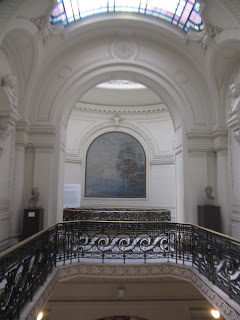



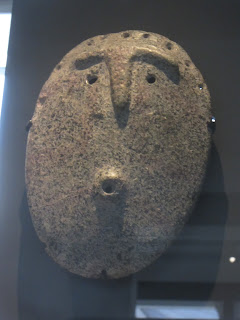










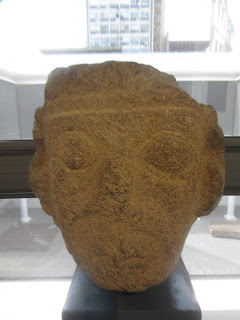











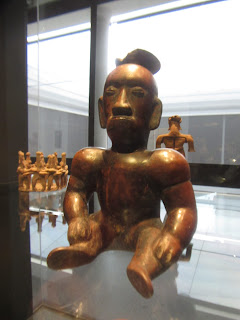




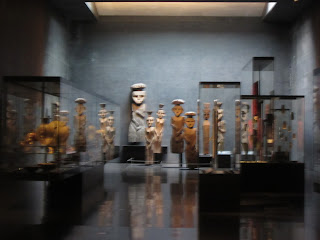













The pre-Colombian section of the MET, however small, has become one of my favorites. Olmec treasures have always fascinated me. Awesome! LU!
ReplyDeleteWill: Steven and I will have to make sure to visit the pre-Colombian section of the Met when next in NYC to see you and Nina. Love you back!
ReplyDeleteI think us North Americans tend to forget about all the history in the Americas and opt for Europe. It is most fascinating. Lil Red
ReplyDelete